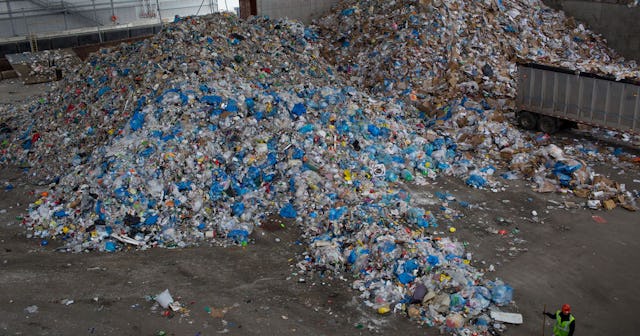Plastic Doesn't Actually Get Recycled Like You Think It Does

Most of the plastic you put in the recycling bin is just going to a landfill
If you live anywhere in America, chances are you have between one and three trash bins outside your home or apartment and one of those is designated for recycling. However, if you’ve been dutifully washing, drying, and recycling all the plastic that comes in and out of your home, it might all be for naught. Over 350 million metric tons of plastic are produced annually across the world, but according to the Organisation for Economic Co-operation and Development, only 14-18% of that is actually recycled. But why? Because it’s cheaper to make new plastic than it is to recycle it.
Essentially, we’ve been sold a lie about recycling thanks to marketing. It makes us feel good to know that recycling exists, but when it comes to plastic, it just goes to the landfill or is burned. Up until two years ago, the U.S. sent the majority of its plastic to Chinese landfills, but now they just land in domestic dumps. It would appear that this is a new problem since China cut off our plastic chain, but according to a new NRP expose, the plastics industry has known about this issue all along.
EPA.gov
According to research from NPR and PBS, the plastic industry sold the public on the idea that the majority of plastic could be recycled, despite knowing it wouldn’t be economically feasible to do so and while making billions of dollars making new plastic. Basically, all used plastic can technically be recycled into new things, but sorting it out is more expensive than just making brand new plastic items from oil and gas. Also, plastic degrades each time it’s reused, so it can only actually be reused once or twice. New plastic is cheaper to produce and of better quality, so there’s literally no financial incentive to recycle old plastic, now add powerful lobbyists for the major oil companies into the mix and well..that’s why we don’t recycle enough plastic.
Hyoung Chang/MediaNews Group/The Denver Post via Getty Images
As for those ubiquitous recycle symbols on the side of plastic containers, industry officials told NPR that the recycle code seen on plastic items is to help recycling facilities sort plastic, but that information hasn’t been clarified to the consumer at all. Ask any person what the recycle symbol means, and most people would tell you that means the plastic is safe to go in the recycling bin. In fact, Earth911 says that if you want to know which plastics you can actually toss in your curbside bin, you have to call your local recycling service provider, as the types of plastics accepted differ by location. For example, those plastic clamshells that strawberries come in during the summer? That’s just one example of something you aren’t supposed to throw in the recycling bin. But since nobody knows which plastics should actually be going to their local recycling center, everyone throws all sorts of different plastic into their recycle bins and it all arrives at the plant and there is no feasible way to sort through it all that makes sense financially. So? Most of that plastic remains unsorted and ends up in a landfill.
As more people are starting to get privy to the plastic disaster, a brand new plastics plant in Texas claims they will recycle 100% of the plastic it makes by the year 2040. Though they don’t know exactly how they’ll achieve that, Jim Becker, the vice president of sustainability for Chevron Phillips’ $6 billion plastics plant told NPR that “recycling has to get more efficient, more economic. We’ve got to do a better job, collecting the waste, sorting it. That’s going to be a huge effort.”
Despite the fact that environmentally-minded companies claim to be committed to developing new sorting and recycling methods, it could likely just be more marketing mumbo jumbo as The World Economic Forum expects plastic production to triple by 2050.
So what can you do? Well, nows a good time to invest in a reusable water bottle and start consuming fewer single-use plastic products.